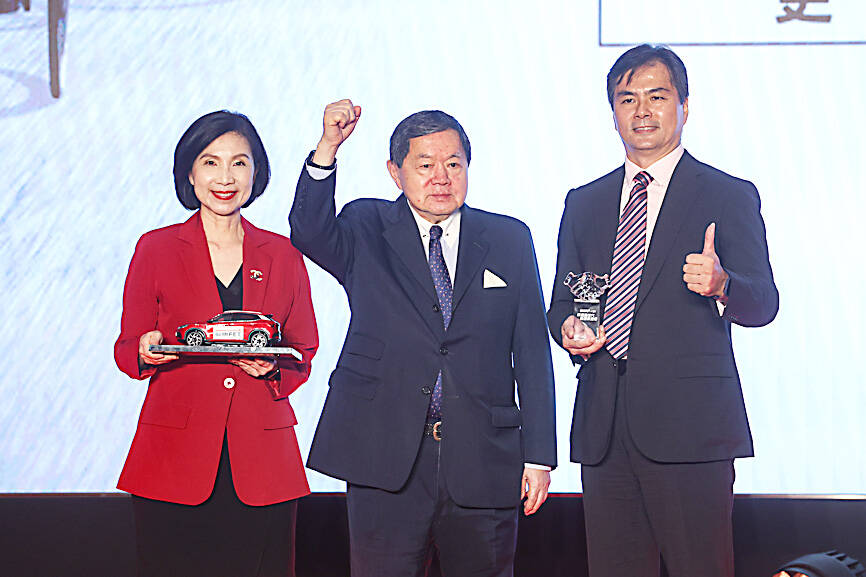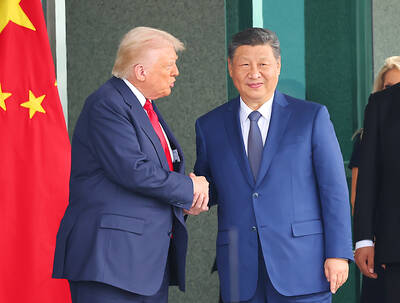Far EasTone Telecommunications Co (遠傳電信) yesterday said it aims to expand its number of mobile subscribers to about 10 million, or about one-third of the market, as part of its strategy in a new competitive landscape following market consolidation.
Far EasTone made the remarks after last month receiving conditional approval from the Fair Trade Commission to acquire Asia Pacific Telecom Co (亞太電信), clearing the final hurdle to proceed with the deal. The transaction is to take effect next quarter.
“The number of telecoms will shrink following the merger of Far EasTone and Asia Pacific, but the market competition will intensify,” Far EasTone chairman Douglas Hsu (徐旭東) told reporters.

Photo: CNA
Far EasTone would be competing head-to-head with its rivals, which have almost identical subscriber bases, following the acquisition of Asia Pacific, company president Chee Ching (井琪) said.
The new entity would have a combined 9.2 million mobile subscribers, lagging behind Chunghwa Telecom Co’s (中華電信) 11.15 million, but ahead of an estimated 9.8 million for Taiwan Mobile Co (台灣大哥大) after it acquires Taiwan Star Telecom Corp (台灣之星).
The nation’s competition watchdog is widely expected to give the go-ahead later this month at the earliest to Taiwan Mobile’s bid to absorb Taiwan Star after wrapping up a 30-day review.
As a result, the number of telecoms in Taiwan would shrink to three from five.
Far EasTone said that more than 36 percent, or about 2 million, of its post-paid subscribers, not including Asia Pacific’s, are 5G users.
To woo more mobile subscribers from rivals, Far EasTone yesterday rolled out new service plans with affordable monthly rates from NT$149 to NT$399 (US$4.66 to US$12.48) and heavy subsidies for smartphones and home appliances.
The new service plans target 4G users and their potential to upgrade to 5G service.
One of its promotions for new 5G service subscribers is a free Samsung smartphone and a rice cooker for a minimum 12-month subscription plan at NT$599 per month plus a NT$1 fee.
Far EasTone expects to complete the network integration with Asia Pacific within one month after it takes effect.
The company would operate 12,500 base stations nationwide as a result of infrastructure optimization, it estimated.
The telecom said it does not expect the merger to incur significant increases in capital spending due to base station additions.
It has budgeted NT$9 billion for this year’s capital expenditure, down from an outlay of NT$9.9 billion last year.
Far EasTone expects the merger to significantly increase its spectrum resource, especially in the low-band bandwidth, or lower-than 1-gigahertz band, which is considered the most efficient band.
Far EasTone would operate 50 megahertz of bandwidth, up 66 percent.
The company’s 5G bandwidth would also rise 50 percent to 120 megahertz.

RUN IT BACK: A succesful first project working with hyperscalers to design chips encouraged MediaTek to start a second project, aiming to hit stride in 2028 MediaTek Inc (聯發科), the world’s biggest smartphone chip supplier, yesterday said it is engaging a second hyperscaler to help design artificial intelligence (AI) accelerators used in data centers following a similar project expected to generate revenue streams soon. The first AI accelerator project is to bring in US$1 billion revenue next year and several billion US dollars more in 2027, MediaTek chief executive officer Rick Tsai (蔡力行) told a virtual investor conference yesterday. The second AI accelerator project is expected to contribute to revenue beginning in 2028, Tsai said. MediaTek yesterday raised its revenue forecast for the global AI accelerator used

Taiwan Semiconductor Manufacturing Co (TSMC, 台積電) has secured three construction permits for its plan to build a state-of-the-art A14 wafer fab in Taichung, and is likely to start construction soon, the Central Taiwan Science Park Bureau said yesterday. Speaking with CNA, Wang Chun-chieh (王俊傑), deputy director general of the science park bureau, said the world’s largest contract chipmaker has received three construction permits — one to build a fab to roll out sophisticated chips, another to build a central utility plant to provide water and electricity for the facility and the other to build three office buildings. With the three permits, TSMC

TEMPORARY TRUCE: China has made concessions to ease rare earth trade controls, among others, while Washington holds fire on a 100% tariff on all Chinese goods China is effectively suspending implementation of additional export controls on rare earth metals and terminating investigations targeting US companies in the semiconductor supply chain, the White House announced. The White House on Saturday issued a fact sheet outlining some details of the trade pact agreed to earlier in the week by US President Donald Trump and Chinese President Xi Jinping (習近平) that aimed to ease tensions between the world’s two largest economies. Under the deal, China is to issue general licenses valid for exports of rare earths, gallium, germanium, antimony and graphite “for the benefit of US end users and their suppliers

Dutch chipmaker Nexperia BV’s China unit yesterday said that it had established sufficient inventories of finished goods and works-in-progress, and that its supply chain remained secure and stable after its parent halted wafer supplies. The Dutch company suspended supplies of wafers to its Chinese assembly plant a week ago, calling it “a direct consequence of the local management’s recent failure to comply with the agreed contractual payment terms,” Reuters reported on Friday last week. Its China unit called Nexperia’s suspension “unilateral” and “extremely irresponsible,” adding that the Dutch parent’s claim about contractual payment was “misleading and highly deceptive,” according to a statement